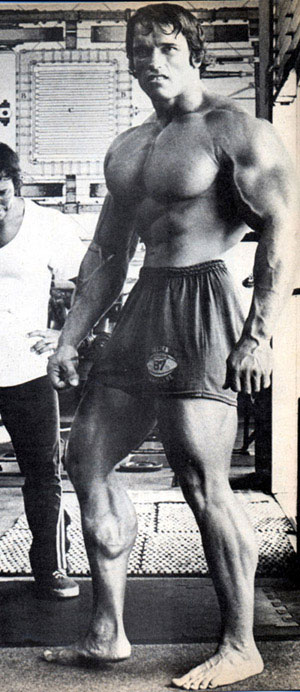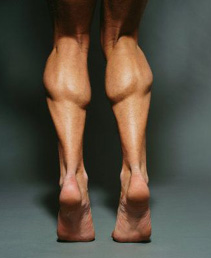May be the number one calf-training mistake is picking the wrong parents, because more than any other bodypart, calf size is determined by genetically structured anatomy. Those with high gastrocnemius can suffer thousands of sets and still have “peg legs”; while others, despite never having entered a gym, possess footballs that seem to sprout from their ankles. You can’t change DNA, so you have to be even more resolute to earn an A in calving. In this article, we show you how to boost your lower-leg grade point average by remedying the most common calf-training errors.
#1 Performing short, low-intensity reps
You likely take anywhere from 3,000 to 10,000 steps daily. Think of each stride as a rep, and you can see how acclimated your calves are to short-range-of-motion, low-intensity work. That’s their thing. To make them grow you need to do what your calves are not accustomed to.
Solutions
- Get a maximum range of motion on each rep.
- Hold each stretch (as low as you can go) for one second and each contraction (as high on your toes as you can get) for two seconds.
- Perform shorter, faster repetitions only after you’ve reached full-rep failure. For example, a set might consist of 10 full reps with top and bottom pauses followed by 10 shorter reps without pauses.
#2 Failure to train all muscles
When you think of calves, you probably think foremost of the heart-shaped gastrocnemius muscles. Your gastrocs are the largest and most visible muscles of your lower legs, but the soleus beneath and below the gastroc also needs to be fully taxed, as do the flexor muscles on your shins, foremost the tibialis anterior. These small shin muscles are not going to wow anyone, but they do set off your calves when viewed from the front, and strengthening them guards against shin splits (a common injury for runners).
Solutions
- The soleus is isolated when your knees are bent at a 90-degree angle, so always include seated calf raises in your calf routine for at least four sets of 10-20 reps.
- The flexor muscles are trained with tibialis raises. If your gym doesn’t have a machine for this, sit on a lying leg-curl bench, hook your toes under the leg pad and, while keeping your knees steady, raise the pad up and back toward your shins. Very little weight will be required. Do three or four sets of 10-20 reps at least every other calf workout.
#3 Insufficient exercise variety
Just as your calves long ago grew accustomed to the same old, plodding repetitions of walking, they acclimate to the same old, plodding repetitions of standing calf raises. Unfortunately, not many exercises isolate your soleus or flexors, although you can do seated calf raises or tibialis raises with both legs simultaneously or one leg at a time. By contrast, there are a lot of exercises for your gastrocnemius, and you can alter each lift for still more variety.
Solutions
- Never do the same gastrocnemius exercise two workouts in a row.
- You may think you’re limited to machine standing calf raises, but here are five more gastroc exercises you can do in most gyms: calf presses on a 45-degree leg press, calf presses on a vertical leg press, calf raises on a hack squat machine (toes on a board), calf raises on a Smith machine (toes on a board), one-leg standing calf raises while holding dumbbells.
- Do some sets for the gastrocnemius with your toes pointed in to hit your lateral (outer) gastroc head and some sets with your toes pointed out to hit the medial (inner) gastroc head. New research presented at the 2009 Annual Meeting of the American College of Sports Medicine confirms that this technique works.
#4 Staying in the same rep range
It’s commonly believed that the calves consist of mostly slow-twitch fibers, since they’re acclimated to the endurance load of walking. In fact, although the soleus does have more slow-twitch than fast-twitch fibers, the gastrocs typically have nearly equal quantities of fast- and slow-twitch fibers. They’re sprinters, as well as marathoners. Furthermore, although there is much empirical evidence that calves respond better to higher reps than other bodyparts do, your calves adapt to rep quantities, whether high or low. Keep them off-guard (and growing) by mixing up your workloads.
Solutions
- Perform mostly moderate- to high-rep sets of 10-20 reps.
- At least every other workout, do some lighter sets of 20-50 reps.
- At least every other workout, do some heavier sets of 6-10 reps.
#5 Not stretching enough
 Just getting the fullest possible range of motion during each rep is not sufficient. You also need to fully stretch your calves between sets and immediately after training them. This increases mobility, enlarges the fascia and boosts the pump, which in turn aids recovery and growth.
Just getting the fullest possible range of motion during each rep is not sufficient. You also need to fully stretch your calves between sets and immediately after training them. This increases mobility, enlarges the fascia and boosts the pump, which in turn aids recovery and growth.
Solutions
- Between sets and immediately after your workout, stand on the edge of a riser, block or stair and let your heels drop as far as possible. Also rise up as high as possible, flex and hold. Stretch your calves individually and together.
- Perform some stretches with your toes pointed in and others with your toes pointed out to elongate both the lateral and medial gastroc heads.
- Stretch your soleus while sitting on a seated calf raise machine, keeping your toes on the riser and letting your heels dip down as far as possible. Alternately, with your knees bent at 90 degrees, bring your toes back toward your shins as far as possible.
Lessons Learned
- Stretch and contract your calves maximally on each rep. Do shorter reps only after reaching full-rep failure.
- Don’t neglect your soleus or flexor muscles.
- Perform a wide variety of calf exercises, and do some sets with your toes pointed in and others with your toes pointed out.
- Keep most sets in the 10-20 range, but sometimes do higher (20-50) or lower (6-10) reps.
- Stretch your calves after each set and after your calf workout.
Author: Greg Merritt, Senior Writer of Flex Magazine
References:
COPYRIGHT 2004 Weider Publications
COPYRIGHT 2008 Gale, Cengage Learning
Flex Magazine
www.findarticles.com
www.flexonline.com










